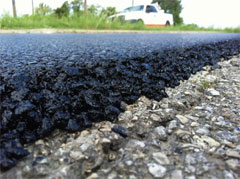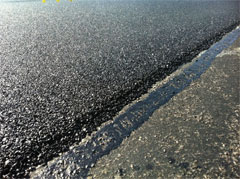With maintenance budgets stretched to their limits, perhaps thin asphalt overlays can fatten those thin budgets a bit. Texas A&M Transportation Institute (TTI) researchers have spent years refining thin asphalt overlay mixes that bridge the gap between high traffic loads and limited maintenance budgets.


Tom Scullion, manager of TTI’s Flexible Pavements Program, and Cindy Estakhri, manager of TTI’s Recyclable Materials Program, are working with the Texas Department of Transportation (TxDOT) to implement the use of three new thin asphalt mixes: a crack-attenuating mix (CAM), fine-graded stone matrix asphalt (SMA) and permeable friction course (PFC).
The goal of the research was to develop mixes that help to reduce costs by using a very thin overlay while retaining quality. The research results indicate that the use of good-quality Grade 5 aggregate is one of the keys. “To place it thin, you need a smaller rock. Grade 5 aggregate is in abundant supply and is almost a waste product at some quarries. We felt we could obtain the Grade 5 aggregate at a reasonable cost,” Estakhri notes.
Researchers wanted mixes that were easy for maintenance personnel to work with, very thin and easy to compact. To ensure the good quality of these mixes, all three of them have to pass the rutting (Hamburg wheel tracking test) and reflection cracking (overlay tester) performance tests.
The CAM mix was not originally intended to be a surface mix. The first purpose for this asphalt-rich mix was as a thin treatment below the surface to retard reflective cracking. In an early project in Houston, a CAM was placed on a high-volume interstate highway and left exposed to traffic for over one year. It performed very well, leading to its modification for use as a thin overlay for surface use. When used as a thin overlay, it’s known as a fine dense-graded mix (DGM) instead of a CAM. By lowering the target density to 96.5 percent, the new DGM has between 0.7 percent and 1.0 percent less asphalt than the original CAM.

The fine-graded PFC was developed as an alternative to seal coat on lower-volume roadways. It drains well and has good friction characteristics. An added benefit is reduced noise compared to seal coats. Estakhri notes that “sometimes people complain about the noise associated with seal coats. Because PFC is finer, it makes for a quieter surface.”
Sarah Horner, assistant area engineer with TxDOT’s Brownwood District, oversaw the recent use of the fine-graded PFC on US 183 in Stephens County. The PFC was laid three quarters of an inch thick in both travel lanes. TxDOT hopes to combat a bleeding issue that compromised the existing surface. (Bleeding occurs when too much asphalt squeezes out on top of the aggregate, and this causes a slick surface.)

“We’re hoping that the open PFC will allow the bleeding to go up into the PFC and keep it away from traffic. We’re also hoping for a smoother, quieter ride,” Horner says. They are expecting at least five years with little or no maintenance from the new PFC surface.
The fine-graded SMA has an excellent surface texture, resists rutting, and is useful on roadways with high volume and numerous intersections. Darlene Goehl, materials engineer for TxDOT’s Bryan District, chose SMA for a recent resurfacing project on the access roads for SH 6. Goehl notes, “We can have problems with seal coats and turning movements. Seal coats often shove [or ripple, creating a washboard effect] in an intersection. We were looking for a rut-resistant, crack-resistant thin mix that we could place in urban areas. We’re expecting 10 to 12 years of service life from the SMA surface.”
All three of the mixes were created as alternatives to seal coats or multiple inches of hot-mix asphalt. “It’s not as cheap as a seal coat, but it will be cheaper than 2 inches of regular hot mix,” says Estakhri. “Currently those are the alternatives. These mixes are in between those options. Even though they are much thinner, we think that these overlay mixes will perform better than 2 inches of hot-mix asphalt.”
Estakhri notes that TxDOT is incorporating these new mixes into its specifications. “Texas has such a huge network of roads to maintain, some in remote areas. TxDOT has to be more creative in terms of extending its dollars to cover more area,” she says.

